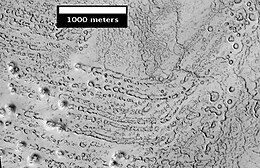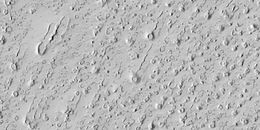
A rootless cone, also formerly called a pseudocrater, is a volcanic landform which resembles a true volcanic crater, but differs in that it is not an actual vent from which lava has erupted. They are characterised by the absence of any magma conduit which connects below the surface of a planet.
Rootless cones are formed by steam explosions as flowing hot lava crosses over a wet surface, such as a swamp, a lake, or a pond. The explosive gases break through the lava surface in a manner similar to a phreatic eruption, and the tephra builds up crater-like forms which can appear very similar to real volcanic craters.
Well known examples are found in Iceland such as the craters in the lake Mývatn (Skútustaðagígar), the Rauðhólar in the region of the capital city Reykjavík or the Landbrotshólar of South-Iceland's Katla UNESCO Global Geopark near Kirkjubæjarklaustur. Rootless cones have also been discovered in the Athabasca Valles region of Mars, where lava flows superheated groundwater in the underlying rocks.
Volcanologists witnessed the formation of a rootless cone for the first time in history during a steam explosion in connection with the first eruption of Eyjafjallajökull in March 2010.
Images
-
 "Rootless Cones" on Mars - due to lava flows interacting with water (MRO, January 4, 2013) (21°57′54″N 197°48′25″E / 21.965°N 197.807°E / 21.965; 197.807).
"Rootless Cones" on Mars - due to lava flows interacting with water (MRO, January 4, 2013) (21°57′54″N 197°48′25″E / 21.965°N 197.807°E / 21.965; 197.807).
-
 "Rootless Cones" on Mars (MRO, January 4, 2008) (25°54′36″N 173°45′36″E / 25.910°N 173.760°E / 25.910; 173.760)
"Rootless Cones" on Mars (MRO, January 4, 2008) (25°54′36″N 173°45′36″E / 25.910°N 173.760°E / 25.910; 173.760)
-
 Rootless Cones, as seen by HiRISE under HiWish program. These group of rings or cones are believed to be caused by lava flowing over water ice or ground containing water ice. The ice quickly changes to steam which blows out a ring or cone.
Rootless Cones, as seen by HiRISE under HiWish program. These group of rings or cones are believed to be caused by lava flowing over water ice or ground containing water ice. The ice quickly changes to steam which blows out a ring or cone.
-
 Rootless Cones, as seen by HiRISE under HiWish program. These group of rings or cones are believed to be caused by lava flowing over water ice or ground containing water ice. The ice quickly changes to steam which blows out a ring or cone. Here the kink in the chain may have been caused by the lava changing direction.
Rootless Cones, as seen by HiRISE under HiWish program. These group of rings or cones are believed to be caused by lava flowing over water ice or ground containing water ice. The ice quickly changes to steam which blows out a ring or cone. Here the kink in the chain may have been caused by the lava changing direction.
-
 Rootless Cones, as seen by HiRISE under HiWish program. These group of rings or cones are believed to be caused by lava flowing over water ice or ground containing water ice. The ice quickly changes to steam which blows out a ring or cone. Here the kink in the chain may have been caused by the lava changing direction. Some of the forms do not have the shape of rings or cones because maybe the lava moved too quickly; thereby not allowing a complete cone shape to form.
Rootless Cones, as seen by HiRISE under HiWish program. These group of rings or cones are believed to be caused by lava flowing over water ice or ground containing water ice. The ice quickly changes to steam which blows out a ring or cone. Here the kink in the chain may have been caused by the lava changing direction. Some of the forms do not have the shape of rings or cones because maybe the lava moved too quickly; thereby not allowing a complete cone shape to form.
-
 Wide view of field of rootless cones, as seen by HiRISE under HiWish program
Wide view of field of rootless cones, as seen by HiRISE under HiWish program
-
 Close view of rootless cones with tails that suggest lava was moving toward the Southwest over ice-rich ground, as seen by HiRISE under HiWish program
Close view of rootless cones with tails that suggest lava was moving toward the Southwest over ice-rich ground, as seen by HiRISE under HiWish program
-
 Close view of cones with the size of a football field shown, as seen by HiRISE under HiWish program
Close view of cones with the size of a football field shown, as seen by HiRISE under HiWish program
See also
References
- Burr, Devon M.; Bruno, Barbara C.; Lanagan, Peter D.; Glaze, Lori S.; Jaeger, Windy L.; Soare, Richard J.; Wan Bun Tseung, Jean-Michel; Skinner, James A.; Baloga, Stephen M. (2009). "Mesoscale raised rim depressions (MRRDs) on Earth: A review of the characteristics, processes, and spatial distributions of analogs for Mars". Planetary and Space Science. 57 (5–6): 579–596. Bibcode:2009P&SS...57..579B. doi:10.1016/j.pss.2008.11.011.
- Jaeger, W. L. et al. (2008) Morphologic Characteristics and Global Distribution of Phreato-volcanic Constructs on Mars as seen by HiRISE, Lunar and Planetary Science XXXIX PDF. Retrieved 2010-07-11.
- Kvöldfréttir Stöðvar Tvö "Viðtal við Ármann Höskuldsson eldfjallafræðing" Fréttastofa Stöðvar Tvö
- Czechowski, Leszek; Zalewska, Natalia; Zambrowska, Anita; Ciazela, Marta; Witek, Piotr; Kotlarz, Jan (2023). "The formation of cone chains in the Chryse Planitia region on Mars and the thermodynamic aspects of this process". Icarus. 396. Bibcode:2023Icar..39615473C. doi:10.1016/j.icarus.2023.115473. S2CID 256787389.
- Czechowski, L., et al. 2023. The formation of cone chains in the Chryse Planitia region on Mars and the thermodynamic aspects of this process. Icarus: Volume 396, 15 May 2023, 115473
External links
- Pseudocraters and Mars (PDF file)
- Cones and Inflated Lava Flows on Mars
- video and pictures of the formation of pseudocraters at Eyjafjallajökull 2010
| Geography and geology of Mars | |||||||||||||||
|---|---|---|---|---|---|---|---|---|---|---|---|---|---|---|---|
| |||||||||||||||
| |||||||||||||||
| |||||||||||||||
